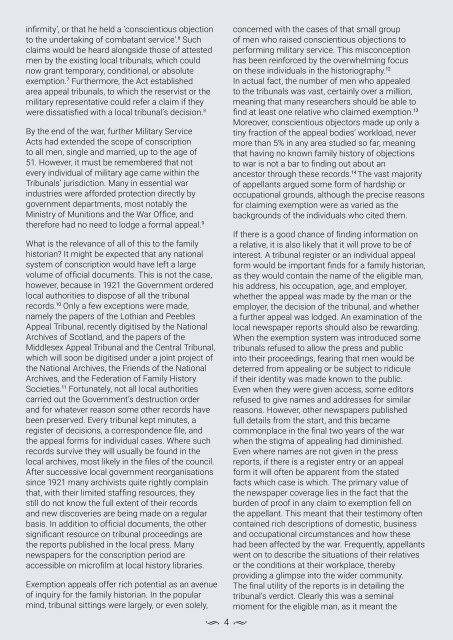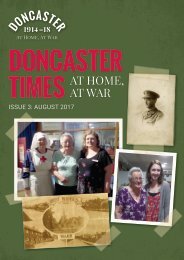Doncaster Times Issue 1 - June 2016
Doncaster Times is a biannual publication of articles and pieces researched and written by members of the public, volunteers and professionals. For its first four years, the magazine will feature articles about Doncaster during the First World War, to commemorate the centenary. The most recent publication is available in hard copy only, available to purchase from Doncaster Museum and Art Gallery, Doncaster Central Library and the Tourist Information Centre.
Doncaster Times is a biannual publication of articles and pieces researched and written by members of the public, volunteers and professionals. For its first four years, the magazine will feature articles about Doncaster during the First World War, to commemorate the centenary. The most recent publication is available in hard copy only, available to purchase from Doncaster Museum and Art Gallery, Doncaster Central Library and the Tourist Information Centre.
You also want an ePaper? Increase the reach of your titles
YUMPU automatically turns print PDFs into web optimized ePapers that Google loves.
infirmity’, or that he held a ‘conscientious objection<br />
to the undertaking of combatant service’. 6 Such<br />
claims would be heard alongside those of attested<br />
men by the existing local tribunals, which could<br />
now grant temporary, conditional, or absolute<br />
exemption. 7 Furthermore, the Act established<br />
area appeal tribunals, to which the reservist or the<br />
military representative could refer a claim if they<br />
were dissatisfied with a local tribunal’s decision. 8<br />
By the end of the war, further Military Service<br />
Acts had extended the scope of conscription<br />
to all men, single and married, up to the age of<br />
51. However, it must be remembered that not<br />
every individual of military age came within the<br />
Tribunals’ jurisdiction. Many in essential war<br />
industries were afforded protection directly by<br />
government departments, most notably the<br />
Ministry of Munitions and the War Office, and<br />
therefore had no need to lodge a formal appeal. 9<br />
What is the relevance of all of this to the family<br />
historian? It might be expected that any national<br />
system of conscription would have left a large<br />
volume of official documents. This is not the case,<br />
however, because in 1921 the Government ordered<br />
local authorities to dispose of all the tribunal<br />
records. 10 Only a few exceptions were made,<br />
namely the papers of the Lothian and Peebles<br />
Appeal Tribunal, recently digitised by the National<br />
Archives of Scotland, and the papers of the<br />
Middlesex Appeal Tribunal and the Central Tribunal,<br />
which will soon be digitised under a joint project of<br />
the National Archives, the Friends of the National<br />
Archives, and the Federation of Family History<br />
Societies. 11 Fortunately, not all local authorities<br />
carried out the Government’s destruction order<br />
and for whatever reason some other records have<br />
been preserved. Every tribunal kept minutes, a<br />
register of decisions, a correspondence file, and<br />
the appeal forms for individual cases. Where such<br />
records survive they will usually be found in the<br />
local archives, most likely in the files of the council.<br />
After successive local government reorganisations<br />
since 1921 many archivists quite rightly complain<br />
that, with their limited staffing resources, they<br />
still do not know the full extent of their records<br />
and new discoveries are being made on a regular<br />
basis. In addition to official documents, the other<br />
significant resource on tribunal proceedings are<br />
the reports published in the local press. Many<br />
newspapers for the conscription period are<br />
accessible on microfilm at local history libraries.<br />
Exemption appeals offer rich potential as an avenue<br />
of inquiry for the family historian. In the popular<br />
mind, tribunal sittings were largely, or even solely,<br />
concerned with the cases of that small group<br />
of men who raised conscientious objections to<br />
performing military service. This misconception<br />
has been reinforced by the overwhelming focus<br />
on these individuals in the historiography. 12<br />
In actual fact, the number of men who appealed<br />
to the tribunals was vast, certainly over a million,<br />
meaning that many researchers should be able to<br />
find at least one relative who claimed exemption. 13<br />
Moreover, conscientious objectors made up only a<br />
tiny fraction of the appeal bodies’ workload, never<br />
more than 5% in any area studied so far, meaning<br />
that having no known family history of objections<br />
to war is not a bar to finding out about an<br />
ancestor through these records. 14 The vast majority<br />
of appellants argued some form of hardship or<br />
occupational grounds, although the precise reasons<br />
for claiming exemption were as varied as the<br />
backgrounds of the individuals who cited them.<br />
If there is a good chance of finding information on<br />
a relative, it is also likely that it will prove to be of<br />
interest. A tribunal register or an individual appeal<br />
form would be important finds for a family historian,<br />
as they would contain the name of the eligible man,<br />
his address, his occupation, age, and employer,<br />
whether the appeal was made by the man or the<br />
employer, the decision of the tribunal, and whether<br />
a further appeal was lodged. An examination of the<br />
local newspaper reports should also be rewarding.<br />
When the exemption system was introduced some<br />
tribunals refused to allow the press and public<br />
into their proceedings, fearing that men would be<br />
deterred from appealing or be subject to ridicule<br />
if their identity was made known to the public.<br />
Even when they were given access, some editors<br />
refused to give names and addresses for similar<br />
reasons. However, other newspapers published<br />
full details from the start, and this became<br />
commonplace in the final two years of the war<br />
when the stigma of appealing had diminished.<br />
Even where names are not given in the press<br />
reports, if there is a register entry or an appeal<br />
form it will often be apparent from the stated<br />
facts which case is which. The primary value of<br />
the newspaper coverage lies in the fact that the<br />
burden of proof in any claim to exemption fell on<br />
the appellant. This meant that their testimony often<br />
contained rich descriptions of domestic, business<br />
and occupational circumstances and how these<br />
had been affected by the war. Frequently, appellants<br />
went on to describe the situations of their relatives<br />
or the conditions at their workplace, thereby<br />
providing a glimpse into the wider community.<br />
The final utility of the reports is in detailing the<br />
tribunal’s verdict. Clearly this was a seminal<br />
moment for the eligible man, as it meant the<br />
4 •<br />
•




